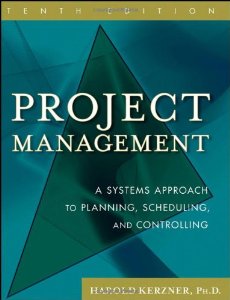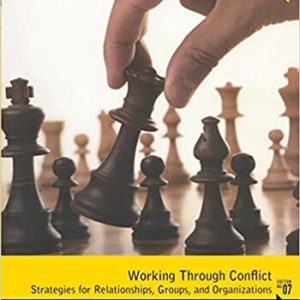Instant download Test Bank for Project Management: A Systems Approach to Planning Scheduling and Controlling, 10 Edition : Harold R. Kerzner Down pdf docx epub after payment.

Product details:
- ISBN-10 : 9781119165354
- ISBN-13 : 978-1119165354
- Author: Harold Kerzner
Project Management, or the “Project Management bible” as it’s widely known, provides practical guidance on all aspects of project management. It features a streamlined approach to PM functions―in full alignment with the concepts and standards outlined in PMI’s latest A Guide to the Project Management Body of Knowledge, (PMBOK® Guide)―without stinting on detailed coverage of the tools and methods used at all stages of a project.
This 12th Edition has been updated to reflect recent changes to the PMBOK® Guide―Sixth Edition, and features in-depth coverage of emerging topics, including global stakeholder management, causes of failure, agile project management, project governance failure, customer approval milestones, classifying project metrics, and more. Also, supplementary materials are available for students, professionals, and instructors.
Table of contents:
Chapter 1: Overview
1.0 Introduction
1.1 Understanding Project Management
1.2 Defining Project Success
1.3 Trade-Offs and Competing Constraints
1.4 The Entry-Level Project Manager
1.5 The Talent Triangle
1.6 Technology-Based Projects
1.7 The Project Manager–Line Manager Interface
1.8 Defining the Project Manager’s Role
1.9 Defining the Functional Manager’s Role
1.10 Defining the Functional Employee’s Role
1.11 Defining the Executive’s Role
1.12 Working with Executives
1.13 Committee Sponsorship/Governance
1.14 The Project Manager as the Planning Agent
1.15 Project Champions
1.16 Project-Driven Versus Non–Project-Driven Organizations
1.17 Marketing in the Project-Driven Organization
1.18 Classification of Projects
1.19 Location of the Project Manager
1.20 Differing Views of Project Management
1.21 Public-Sector Project Management
1.22 International Project Management
1.23 Concurrent Engineering: A Project Management Approach
1.24 Added Value
1.25 Studying Tips for the PMI® Project Management Certification Exam
Answers
Problems
Case Study: Williams Machine Tool Company
Chapter 2: Project Management Growth: Concepts and Definitions
2.0 Introduction
2.1 The Evolution of Project Management: 1945–2021
2.2 Resistance to Change
2.3 Systems, Programs, and Projects: A Definition
2.4 Projects versus Operations
2.5 Product versus Project Management: A Definition
2.6 Maturity and Excellence: A Definition
2.7 Informal Project Management: A Definition
2.8 The Many Faces of Success
2.9 The Many Faces of Failure
2.10 Causes of Project Failure
2.11 Degrees of Success and Failure
2.12 Project Health Checks
2.13 The Stage-Gate Process
2.14 Project Life Cycles
2.15 Gate Review Meetings (Project Closure)
2.16 Engagement Project Management
2.17 Project Management Methodologies: A Definition
2.18 From Enterprise Project Management Methodologies to Frameworks
2.19 Growth of Strategic Project Management
2.20 Business Models
2.21 Methodologies Can Fail
2.22 Lean Project Management
2.23 Organizational Change Management and Corporate Cultures
2.24 Benefits Harvesting and Cultural Change
2.25 Agile and Adaptive Project Management Cultures
2.26 Project Management Intellectual Property
2.27 Systems Thinking
2.28 Studying Tips for the PMI® Project Management Certification Exam
Answers
Problems
Case Study: Creating a Methodology
Chapter 3: Organizational Structures
3.0 Introduction
3.1 Organizational Work Flow
3.2 Traditional (Classical) Organization
3.3 Pure Product (Projectized) Organization
3.4 Matrix Organizational Form
3.5 Modification of Matrix Structures
3.6 The Strong, Weak, or Balanced Matrix
3.7 Project Management Offices
3.8 Selecting the Organizational Form
3.9 Strategic Business Unit (SBU) Project Management
3.10 Transitional Management
3.11 Seven Fallacies That Delay Project Management Maturity
3.12 Studying Tips for the PMI® Project Management Certification Exam
Answers
Problems
Chapter 4: Organizing and Staffing the Project Office and Team
4.0 Introduction
4.1 The Staffing Environment
4.2 Selecting the Project Manager: An Executive Decision
4.3 Skill Requirements for Project and Program Managers
4.4 Special Cases in Project Manager Selection
4.5 Today’s Project Managers
4.6 Duties and Job Descriptions
4.7 The Organizational Staffing Process
4.8 The Project Office
4.9 The Functional Team
4.10 The Project Organizational Chart
4.11 Selecting the Project Management Implementation Team
4.12 Mistakes Made by Inexperienced Project Managers
4.13 Studying Tips for the PMI®Project Management Certification Exam
Answers
Problems
Chapter 5: Management Functions
5.0 Introduction
5.1 Controlling
5.2 Directing
5.3 Project Authority
5.4 Interpersonal Influences
5.5 Barriers to Project Team Development
5.6 Suggestions for Handling the Newly Formed Team
5.7 Team Building as an Ongoing Process
5.8 Leadership in a Project Environment
5.9 Value-Based Project Leadership
5.10 Transformational Project Management Leadership
5.11 Organizational Impact
5.12 Employee–Manager Problems
5.13 General Management Pitfalls
5.14 Time Management Pitfalls
5.15 Management Policies and Procedures
5.16 Human Behavior Education
5.17 Studying Tips for the PMI® Project Management Certification Exam
Answers
Problems
Case Study: The Trophy Project
Case Study: McRoy Aerospace
Case Study: The Poor Worker
Case Study: The Prima Donna
Case Study: The Reluctant Workers
Case Study: Leadership Effectiveness (A)
Case Study: Leadership Effectiveness (B)
Chapter 6: Communications Management
6.0 Introduction
6.1 Modeling the Communications Environment
6.2 The Project Manager as a Communicator
6.3 Project Review Meetings
6.4 Project Management Bottlenecks
6.5 Active Listening
6.6 Communication Traps
6.7 Project Problem Solving
6.8 Using Action Items
6.9 Brainstorming
6.10 Predicting the Outcome of a Decision
6.11 Facilitation
6.12 Studying Tips for the PMI® Project Management Certification Exam
Answers
Problems
Case Study: Communication Failures
Case Study: The Team Meeting
Chapter 7: Conflicts
7.0 Introduction
7.1 The Conflict Environment
7.2 Types of Conflicts
7.3 Conflict Resolution
7.4 The Management of Conflicts
7.5 Conflict Resolution Modes
7.6 Understanding Superior, Subordinate, and Functional Conflicts
7.7 Studying Tips for the PMI® Project Management Certification Exam
Problems
Case Study: Facilities Scheduling at Mayer Manufacturing
Case Study: Telestar International
Case Study: Handling Conflict in Project Management
Chapter 8: Special Topics
8.0 Introduction
8.1 Performance Measurement
8.2 Financial Compensation and Rewards
8.3 Effective Project Management in the Small Business Organization
8.4 Mega Projects
8.5 Morality, Ethics, and the Corporate Culture
8.6 Professional Responsibilities
8.7 Internal and External Partnerships
8.8 Training and Education
8.9 Integrated Product/Project Teams
8.10 Virtual Project Teams
8.11 Managing Innovation Projects
8.12 Agile Project Management
8.13 Artificial Intelligence
8.14 Studying Tips for the PMI® Project Management Certification Exam
Answers
Problems
Case Study: Is It Fraud?
Chapter 9: The Variables for Success
9.0 Introduction
9.1 Predicting Project Success
9.2 Project Management Effectiveness
9.3 Expectations
9.4 Lessons Learned
9.5 Understanding Best Practices
9.6 Downside Risks of Best Practices
9.7 Studying Tips for the PMI® Project Management Certification Exam
Answers
Problems
Case Study: Radiance International
Chapter 10: Working with Executives
10.0 Introduction
10.1 The Project Sponsor
10.2 Handling Disagreements with the Sponsor
10.3 The Collective Belief
10.4 The Exit Champion
10.5 The In-House Representatives
10.6 Stakeholder Relations Management
10.7 Project Portfolio Management
10.8 Politics
10.9 Studying Tips for the PMI® Project Management Certification Exam
Answers
Problems
Case Study: The Prioritization of Projects
Case Study: The Irresponsible Sponsors
Case Study: Selling Executives on Project Management
Chapter 11: Planning
11.0 Introduction
11.1 Business Case
11.2 Validating the Assumptions
11.3 Validating the Objectives
11.4 General Planning
11.5 Life-Cycle Phases
11.6 Life-Cycle Milestones
11.7 Kickoff Meetings
11.8 Understanding Participants’ Roles
11.9 Establishing Project Objectives
11.10 The Statement of Work
11.11 Project Specifications
11.12 Data Item Milestone Schedules
11.13 Work Breakdown Structure
11.14 WBS Decomposition Problems
11.15 Work Breakdown Structure Dictionary
11.16 Project Selection
11.17 Role of the Executive in Planning
11.18 Management Cost and Control System
11.19 Work Planning Authorization
11.20 Why Do Plans Fail?
11.21 Stopping Projects
11.22 Handling Project Phaseouts and Transfers
11.23 Detailed Schedules and Charts
11.24 Master Production Scheduling
11.25 Project Plan
11.26 The Project Charter
11.27 Project Baselines
11.28 Verification and Validation
11.29 Management Control
11.30 Configuration Management
11.31 Enterprise Project Management Methodologies
11.32 Project Audits
11.33 Studying Tips for the PMI® Project Management Certification Exam
Answers
Problems
Chapter 12: Network Scheduling Techniques
12.0 Introduction
12.1 Network Fundamentals
12.2 Graphical Evaluation and Review Technique (GERT)
12.3 Dependencies
12.4 Slack Time
12.5 Network Replanning
12.6 Estimating Activity Time
12.7 Estimating Total Project Time
12.8 Total Pert/CPM Planning
12.9 Crash Times
12.10 PERT/CPM Problem Areas
12.11 Alternative PERT/CPM Models
12.12 Precedence Networks
12.13 Lag
12.14 Scheduling Problems
12.15 The Myths of Schedule Compression
12.16 Project Management Software
12.17 Studying Tips for the PMI® Project Management Certification Exam
Answers
Problems
Case Study: The Invisible Sponsor
Chapter 13: Pricing and Estimating
13.0 Introduction
13.1 Global Pricing Strategies
13.2 Types of Estimates
13.3 Pricing Process
13.4 Organizational Input Requirements
13.5 Labor Distributions
13.6 Overhead Rates
13.7 Materials/Support Costs
13.8 Pricing out the Work
13.9 Smoothing Out Department Man-Hours
13.10 The Pricing Review Procedure
13.11 Systems Pricing
13.12 Developing the Supporting/Backup Costs
13.13 The Low-Bidder Dilemma
13.14 Special Problems
13.15 Estimating Pitfalls
13.16 Estimating High-Risk Projects
13.17 Project Risks
13.18 The Disaster of Applying the 10 Percent Solution to Project Estimates
13.19 Life-Cycle Costing (LCC)
13.20 Logistics Support
13.21 Economic Project Selection Criteria: Capital Budgeting
13.22 Payback Period
13.23 The Time Value of Money and Discounted Cash Flow (DCF)
13.24 Net Present Value (NPV)
13.25 Internal Rate of Return (IRR)
13.26 Comparing IRR, NPV, and Payback
13.27 Risk Analysis
13.28 Capital Rationing
13.29 Project Financing
13.30 Studying Tips for the PMI® Project Management Certification Exam
Answers
Problems
Case Study: The Estimating Problem
Chapter 14: Cost Control
14.0 Introduction
14.1 Understanding Control
14.2 The Operating Cycle
14.3 Cost Account Codes
14.4 Budgets
14.5 The Earned Value Measurement System (EVMS)
14.6 Variance and Earned Value
14.7 The Cost Baseline
14.8 Justifying the Costs
14.9 The Cost Overrun Dilemma
14.10 Recording Material Costs Using Earned Value Measurement
14.11 Material Variances: Price and Usage
14.12 Summary Variances
14.13 Status Reporting
14.14 Cost Control Problems
14.15 Studying Tips for the PMI® Project Management Certification Exam
Answers
Problems
Case Study: The Bathtub Period
Case Study: Franklin Electronics
Chapter 15: Metrics
15.0 Introduction
15.1 Project Management Information Systems
15.2 Enterprise Resource Planning
15.3 Project Metrics
15.4 Key Performance Indicators (KPIs)
15.5 Growth of New Metrics and KPIs
15.6 Value-Based Metrics
15.7 Strategic Metrics
15.8 Metrics for Measuring Intangible Assets
15.9 Dashboards and Scorecards
15.10 Metrics Feedback
15.11 Metrics and Customer Relations Management
15.12 Business Intelligence
15.13 Studying Tips for the PMI®Project Management Certification Exam
Answers
Problems
Chapter 16: Trade-off Analysis in a Project Environment
16.0 Introduction
16.1 Methodology for Trade-Off Analysis
16.2 Contracts: Their Influence on Projects
16.3 Industry Trade-Off Preferences
16.4 Project Manager’s Control of Trade-Offs
16.5 Studying Tips for the PMI® Project Management Certification Exam
Answers
Problems
Chapter 17: Risk Management
17.0 Introduction
17.1 Definition of Risk
17.2 Tolerance for Risk
17.3 Definition of Risk Management
17.4 Certainty, Risk, and Uncertainty
17.5 Risk Management Process
17.6 Plan Risk Management
17.7 Risk Identification
17.8 Risk Analysis
17.9 Qualitative Risk Analysis
17.10 Quantitative Risk Analysis
17.11 Plan Risk Response
17.12 Monitor and Control Risks
17.13 Some Implementation Considerations
17.14 The Use of Lessons Learned
17.15 Dependencies between Risks
17.16 The Impact of Risk Handling Measures
17.17 Risk and Concurrent Engineering
17.18 Studying Tips for the PMI® Project Management Certification Exam
Answers
Problems
Case Study: Teloxy Engineering (A)
Case Study: Teloxy Engineering (B)
Case Study: The Risk Management Department
Chapter 18: Learning Curves
18.0 Introduction
18.1 General Theory
18.2 The Learning Curve Concept
18.3 Graphic Representation
18.4 Key Words Associated with Learning Curves
18.5 The Cumulative Average Curve
18.6 Sources of Experience
18.7 Developing Slope Measures
18.8 Unit Costs and Use of Midpoints
18.9 Selection of Learning Curves
18.10 Follow-on Orders
18.11 Manufacturing Breaks
18.12 Learning Curve Limitations
18.13 Competitive Weapon
18.14 Studying Tips for the PMI® Project Management Certification Exam
Answers
Problems
Chapter 19: Contract Management
19.0 Introduction
19.1 Procurement
19.2 Plan Procurements
19.3 Conducting the Procurements
19.4 Conduct Procurements: Request Seller Responses
19.5 Conduct Procurements: Select Sellers
19.6 Types of Contracts
19.7 Incentive Contracts
19.8 Contract Type versus Risk
19.9 Contract Administration
19.10 Contract Closure
19.11 Using a Checklist
19.12 Proposal-Contractual Interaction
19.13 Studying Tips for the PMI® Project Management Certification Exam
Answers
Problems
Case Study: To Bid or Not to Bid
Case Study: The Management Reserve
Chapter 20: Quality Management
20.0 Introduction
20.1 Definition of Quality
20.2 The Quality Movement
20.3 Quality Management Concepts
20.4 The Cost of Quality
20.5 The Seven Quality Control Tools
20.6 Acceptance Sampling
20.7 Implementing Six Sigma
20.8 Quality Leadership
20.9 Responsibility for Quality
20.10 Quality Circles
20.11 Total Quality Management (TQM)
20.12 Studying Tips for the PMI®Project Management Certification Exam
Answers
Problems
Chapter 21: Modern Developments in Project Management
21.0 Introduction
21.1 The Project Management Maturity Model (PMMM)
21.2 Developing Effective Procedural Documentation
21.3 Project Management Methodologies
21.4 Continuous Improvement
21.5 Capacity Planning
21.6 Competency Models
21.7 Managing Multiple Projects
21.8 The Business of Scope Changes
21.9 End-of-Phase Review Meetings
Case Study: Honicker Corporation
Case Study: Kemko Manufacturing
Appendix A: Solution to Leadership Exercise
Appendix B: Solutions to the Project Management Conflict Exercise
Appendix C: Dorale Products Case Studies
Appendix D: Solutions to the Dorale Products Case Studies
Appendix E: Alignment of the PMBOK® Guide, 6e to the Text
Appendix F: Alignment of the PMBOK® Guide, 7e to the Text
Index
People also search:
Project Management: A Systems Approach to Planning, Scheduling, and Controlling
Project Management: A Systems Approach to Planning, Scheduling, and Controlling Harold R. Kerzner
Project Management: A Systems Approach to Planning, Scheduling, and Controlling Harold R. Kerzner 10
Project Management: A Systems Approach to Planning, Scheduling, and Controlling Harold R. Kerzner 10 Test Bank
Test Bank for Project Management: A Systems Approach to Planning Scheduling and Controlling, 10 Edition : Harold R. Kerzner Down





